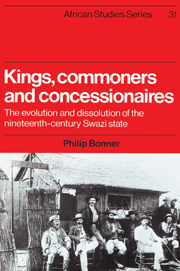 Kings, Commoners and Concessionaires
Kings, Commoners and Concessionaires Book contents
- Frontmatter
- Contents
- List of maps
- List of figures
- Preface
- Map 1 Modern Swaziland
- Map 2 Chiefdoms c. 1820
- 1 Introduction
- 2 The northern Nguni states 1700–1815
- 3 The conquest state 1820–1838
- 4 Factions and fissions: Mswati's early years
- 5 The balance tilts: Swazi–Boer relations 1852–1865
- 6 The deepening and widening of Dlamini power 1852–1865
- 7 Regency and retreat 1865–1874
- 8 Confederation, containment and conciliar rule: Mbandzeni's apprenticeship 1874–1881
- 9 The puff–adder stirs: Mbandzeni and the beginnings of concessions 1881–1886
- 10 The conquest by concessions 1886–1889
- 11 Conclusion
- Appendix
- Notes
- Bibliography
- Index
- KINGS, COMMONERS AND CONCESSIONAIRES
4 - Factions and fissions: Mswati's early years
Published online by Cambridge University Press: 22 September 2009
- Frontmatter
- Contents
- List of maps
- List of figures
- Preface
- Map 1 Modern Swaziland
- Map 2 Chiefdoms c. 1820
- 1 Introduction
- 2 The northern Nguni states 1700–1815
- 3 The conquest state 1820–1838
- 4 Factions and fissions: Mswati's early years
- 5 The balance tilts: Swazi–Boer relations 1852–1865
- 6 The deepening and widening of Dlamini power 1852–1865
- 7 Regency and retreat 1865–1874
- 8 Confederation, containment and conciliar rule: Mbandzeni's apprenticeship 1874–1881
- 9 The puff–adder stirs: Mbandzeni and the beginnings of concessions 1881–1886
- 10 The conquest by concessions 1886–1889
- 11 Conclusion
- Appendix
- Notes
- Bibliography
- Index
- KINGS, COMMONERS AND CONCESSIONAIRES
Summary
The heir apparent was Mswati, a young boy of thirteen. On purely constitutional gounds he had an almost watertight claim. His mother, Thandile, was regarded as Sobhuza's chief wife, and he himself did not suffer from any obvious disabilities, like a younger full brother or a disabled right hand. His succession for all that was controversial and stormy, and he had to ride out a series of challenges in the first decade of his reign. When considered against the particular history of this area, and ‘Bantu speaking’ succession practices in general, this should not perhaps be a cause for much surprise. In African societies throughout southern Africa, succession laws are not as fixed or readily interpretable as has often been assumed. Among the Rolong, for example, Comaroff shows how succession laws can be manipulated to the point of even ousting established chiefs, and how custom can then be retrospectively reinterpreted to tally with that claim. The Swazi have not usually gone to such lengths, but on occasions were not above ignoring old principles and manufacturing new ones to put in their place. Thus one hears in the mid-eighteenth century of Magudlela being excluded from the succession because he was left-handed, and Ndlela being overlooked because he had a younger full brother, both of which have a suspiciously retrospective ring, while the controversies surrounding the succession of Sobhuza suggest that even he did not possess a generally acceptable claim.
- Type
- Chapter
- Information
- Kings, Commoners and ConcessionairesThe Evolution and Dissolution of the Nineteenth-Century Swazi State, pp. 47 - 64Publisher: Cambridge University PressPrint publication year: 1983


